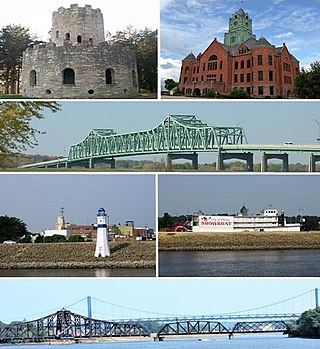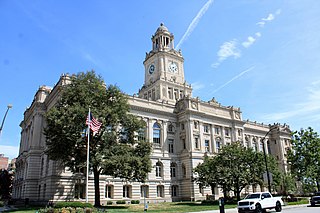
Clinton is a city in and the county seat of Clinton County, Iowa, United States. The population was 24,469 as of 2020. Clinton, along with DeWitt, was named in honor of the sixth governor of New York, DeWitt Clinton. Clinton is the principal city of the Clinton Micropolitan Statistical Area, which is coterminous with Clinton County. Clinton was incorporated on January 26, 1857.

Volga is a city in Brookings County, South Dakota, United States with a population of 2,113 at the 2020 census.

Tenino is a city in Thurston County, Washington, United States. The population was 1,870 at the 2020 census.

The Merchants' National Bank (1914) building is a historic commercial building located in Grinnell, Iowa. It is one of a series of small banks designed by Louis Sullivan in the Midwest between 1909 and 1919. All of the banks are built of brick and for this structure he employed various shades of brick, ranging in color from blue-black to golden brown, giving it an overall reddish brown appearance. It was declared a National Historic Landmark in 1976 for its architecture. In 1991 it was listed as a contributing property in the Grinnell Historic Commercial District.

May's Island is a small island on the Cedar River, in Cedar Rapids, Iowa. Functioning as a civic center much like the Île de la Cité, it is the site of the Memorial Building, the Linn County Courthouse, and the county jail. The island plus an adjacent block was listed as a historic district on the National Register of Historic Places in 1978.

The Chicago, Milwaukee, St. Paul and Pacific Freight House, known locally as The Freight House, is a historic building in Downtown Davenport, Iowa, United States. It was listed on the National Register of Historic Places in 1985.

The Crescent Warehouse Historic District is a 10.5-acre (4.2 ha) historic district in Downtown Davenport, Iowa, United States. The district is a collection of multi-story brick structures that formerly housed warehouses and factories. Most of the buildings have been converted into loft apartments. The district was listed on the National Register of Historic Places in 2003.

Davenport Bank and Trust Company was for much of the 20th century the leading bank of the Quad Cities metropolitan area and the surrounding region of eastern Iowa and western Illinois. It was at one time Iowa's largest commercial bank, and the headquarters building has dominated the city's skyline since it was constructed in 1927 at the corner of Third and Main Streets in downtown Davenport, Iowa. It was acquired by Norwest Bank of Minneapolis in 1993 and now operates as part of Wells Fargo following a 1998 merger of the two financial institutions. The historic building was listed on the National Register of Historic Places in 1983 under the name of its predecessor financial institution American Commercial and Savings Bank. In 2016 the National Register approved a boundary increase with the Davenport Bank and Trust name. It was included as a contributing property in the Davenport Downtown Commercial Historic District in 2020. It remains the tallest building in the Quad Cities, and is today known as Davenport Bank Apartments as it has been redeveloped into a mixed-use facility housing commercial, office, and residential space.

The Jamaica Savings Bank was a bank incorporated in 1866 in the Jamaica section of the borough of Queens in New York City. It had four branches across Queens before it was acquired by North Fork Bank in 1999, which itself was acquired by Capital One Bank in 2008.

The Cass County Courthouse in Atlantic, Iowa, United States, was built in 1934 as the first courthouse in the state built with funding from the Public Works Administration (PWA). It was listed on the National Register of Historic Places in 2003 as a part of the PWA-Era County Courthouses of Iowa Multiple Properties Submission. The courthouse is the third structure to house court functions and county administration.

The Polk County Courthouse located in Des Moines, Iowa, United States, was built in 1906. It was listed on the National Register of Historic Places in 1979 as a part of the County Courthouses in Iowa Thematic Resource. The courthouse is the third building the county has used for court functions and county administration.

The Fayette County Courthouse in West Union, Iowa, United States was built in 1923. It was listed on the National Register of Historic Places in 1981 as a part of the County Courthouses in Iowa Thematic Resource. In 2015 it was included as a contributing property in the West Union Commercial Historic District. The current courthouse is the third facility to house court functions and county administration.

The Benton County Courthouse, located in Vinton, Iowa, United States, was built in 1906. It was listed on the National Register of Historic Places in 1976 as a part of the County Courthouses in Iowa Thematic Resource. The courthouse is the fourth building the county has used for court functions and county administration.

Farmers and Merchants Savings Bank, also known as Union Savings Bank and First Trust and Savings Bank, is an historic building located in Grand Mound, Iowa, United States. It was listed on the National Register of Historic Places in 2001.

The Newton Downtown Historic District is a nationally recognized historic district located in Newton, Iowa, United States. It was listed on the National Register of Historic Places in 2014. At the time of its nomination it contained 85 resources, which included 60 contributing buildings, one contributing site, and 24 non-contributing buildings. Jasper County was established by the Iowa Territorial Legislature in 1846, and Newton was incorporated the following year as the county seat. The town grew slowly at first around the Jasper County Courthouse. Businesses largely served the needs of the local farmers as well as the town's residents. The Mississippi and Missouri Railroad, later the Chicago, Rock Island and Pacific Railroad, came to Newton in 1867. This changed the town's economy from agricultural-based to manufacturing, and the central business district expanded outward as the community grew. Several washing machine companies established themselves in Newton, most notably Maytag. The emergence of Maytag as a major corporation in the mid-20th century led to the transformation of the downtown area. Between 1951 and 1952, 18 businesses installed new storefronts, transforming them from their original Victorian appearance to a more modern appearance. The modernization continued into the 1960s.

The First Federal Savings and Loan Association Building is a historic building located in Downtown Davenport, Iowa, United States. It was individually listed on the Davenport Register of Historic Properties and on the National Register of Historic Places in 2016. In 2020 it was included as a contributing property in the Davenport Downtown Commercial Historic District.

Hotel Lester-Lester Cafe, also known as the Dodge House-Long Branch, is a historic building located in Mason City, Iowa, United States. Its construction, completed in 1915, was a project undertaken by local real estate developer Meir Wolf. It was built as a two-story building a block away from the passenger and freight depots of the Chicago and North Western Railroad and the Chicago Great Western Railway. The building was meant to be used as a railroad hotel so passengers and rail employees would not have to travel the six to eight blocks to the hotels downtown. It is the only remaining railroad hotel left in Mason City. Hotel guests stayed in the 29 rooms on the second floor, and three commercial spaces on the first floor were occupied by a variety of restaurants, grocery stores and barbershops. Its most famous guest was track star Jesse Owens, who was in town in December 1937 for a basketball exhibition. He could not stay at the other hotels in town because of his race. In 1975 the hotel's name was changed to the Dodge House and the Long Branch Saloon occupied the space that had previously housed a cafe. By that time it was largely used as a rooming house, and it was used to house the homeless. The building was listed on the National Register of Historic Places in 2002.

The First National Bank of Davenport, also known as Brenton Bank and The Brenton, is a historic building located in central Davenport, Iowa, United States. It was added to the National Register of Historic Places in 2018. It is significant for its associations with the history of community planning and development, and as an important example of modernistic design.

The Freedman's Bank Building, previously known as the Treasury Annex, is a historic office building located on the corner of Madison Place and Pennsylvania Avenue NW in Washington, D.C. It sits on the east side of Lafayette Square, a public park on the north side of the White House, and across from the Treasury Building. The adjoining properties include the Howard T. Markey National Courts Building to the north and the former Riggs National Bank to the east.






















